Even behemoths such as Amazon make strategic errors. The failure of the Amazon Fire Phone in 2014 is a prime example. What was the reason behind this failure? No one wanted this phone except Amazon. The gadget was designed to allow customers to connect directly to their shopping platform.
Customers had previously used iPhones and Android phones to access Amazon. This oversight in customer research led to a vast and costly blunder.
MVP (minimum viable product) can be defined in various ways. However, at its core, it refers to a product created with the smallest elements possible to deliver maximum customer value.
But what exactly does the smallest set of features imply? And, more importantly, how can we define it? To succeed, you must ensure that the product you sell is what customers need. Thus, the dilemma arises: what is it supposed to look like?
Developing an MVP may provide the answer. But how do you create an MVP plan? This detailed guide will cover the nuances of developing your minimum viable product roadmap.
What is a minimum viable product (MVP) roadmap?
A minimum viable product (MVP) roadmap is a tool that startups and businesses can use to determine which features or products to release to validate their business idea with the least amount of resources and time.
The minimum viable product is an initial version of a product with just enough features to test whether it may be successful in the market. It allows early testers to try out the product.
The goal of the minimal viable product is to understand the concept's value without wasting too much time developing it. It helps you comprehend your customers' needs and reactions to your product's features and functionality.
However, what should we include in the MVP, and what criteria should we consider while determining it? We will be answering this vital question further, but before doing so, let's understand the reason behind building a minimum viable product.
What is the purpose of an MVP?
Creating an MVP aims to develop your product quickly based on a tested concept with a limited budget.
This method allows businesses to significantly reduce the chances of making mistakes in the product development process by enabling companies to focus on one thing at a time.
By concentrating feedback on specific groups or user types, an MVP aids in the gathering of high-quality data.
In the manufacturing sector, an MVP can help test new technologies like Industry 4.0 and digital twins to improve production processes and supply chain resilience. Learn more about how we support the manufacturing industry.
Ready to conquer the startup universe with your groundbreaking MVP? Get ready to outshine and impress like never before. Let your MVP do the talking and create an unforgettable impact. So, why wait? Ignite your MVP journey now and watch your vision transform into reality!
Give your MVP a perfect headstart with our free & editable template!
Download Now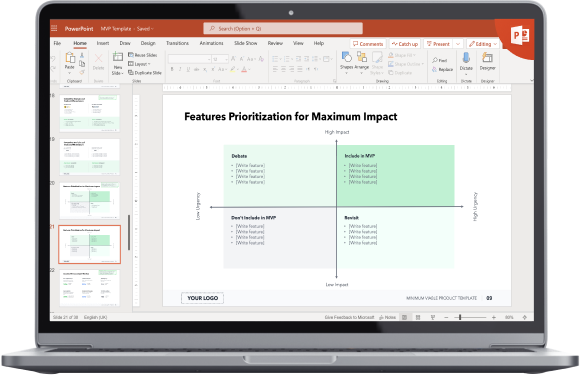
Our template is your rocket ship to success. Immerse it in your product's unique details, and watch as your MVP takes flight towards an extraordinary journey. Enjoy full customization, save precious time, and employ proven frameworks to showcase your innovation at its best. Let's create a new narrative for your MVP together.
Why should you build a minimum viable product?
Creating an MVP roadmap aims to help startups and businesses save time and resources by developing only the most essential features of their business ideas.
In the logistics sector, an MVP can help test new systems for tracking and delivery optimization, ensuring smooth operations even during disruptions. Discover how our digital solutions enhance logistics operations on our logistics industry page.
Startups and businesses can reduce the risk of failure and increase the chances of success by validating a business idea with an MVP.
The development process for an MVP should be started as soon as possible and should not be delayed. Why? Because if MVP is not built at the right time, you risk the chances of:
- Running out of cash
- Entering an unsuitable sector
- Conducting insufficient competitive research
However, following the MVP development approach may reduce risks. Every product creation begins with certain preconceptions about potential customers and how they will use it. Following the MVP development process step-by-step allows you to validate your assumptions.
It's an iterative process for building, measuring, learning, and checking on expectations to ensure that things stay improved. You provide a minimal product to target users and enhance it as you learn more about them.
After that, you collect data on users of the product to improve it. This additional information is again incorporated into the iterative model, which aids in decision-making.
This is when you should thoroughly evaluate the product and its key features. You'll then determine which aspects of your product to focus on in the later stage of its lifecycle.
Reasons to build a minimum viable product
There are many reasons to build an MVP. The main reason is to reduce the risks and costs of launching a new product. Here are some other reasons:
- Validate your product idea
- Gather feedback from users
- Assess market demand
- Save time and money
- Test the feasibility of your idea
- Reduce development risks
- Help get early adopters
- Improve chances of success
Regarding digital product strategy and minimum viable product, the key is not to be afraid to take risks and experiment.
Rather than spending months or years developing a fully-fledged product, an MVP allows you to quickly launch a basic version of your product and gather user feedback. This approach allows for rapid iteration and refinement, ultimately leading to a better end product.
A digital product strategy incorporating MVPs can help businesses stay agile and adapt to changing market conditions, giving them a competitive advantage in the digital landscape. Remember, the only constant in the digital world is changing, so it's important to be flexible and willing to pivot your strategy as needed.
What are the benefits of building an MVP?
An MVP allows you to test your product with a small group of users before investing in its development.
This can save you time and money in the long run as you can ensure that your product is viable and there is a demand before fully committing to its development.
This approach is particularly useful in retail, where testing new shopping experiences and personalized customer interactions can lead to significant improvements in customer satisfaction and loyalty. Explore how we help retailers thrive in the digital age on our retail industry page.
Dropbox is an excellent illustration of how to take advantage of an MVP to define success. As a result, they've become a successful business with a net worth of $12 billion.
Many file-sharing services existed when Dropbox was first founded—they weren't all that great, and few people used them.
The Dropbox hypothesis was that a well-executed product would be phenomenally successful.
Here's the hard part: they needed to do this well across even the most prominent platforms, like OSX, Windows, iOS, and others. It was a tremendous job, and they needed cash.
Venture capitalists hesitated to enter a market where existing rivals suffered, which caused many investors to shy away.
Here's how the Dropbox team derived the solution to their problem:
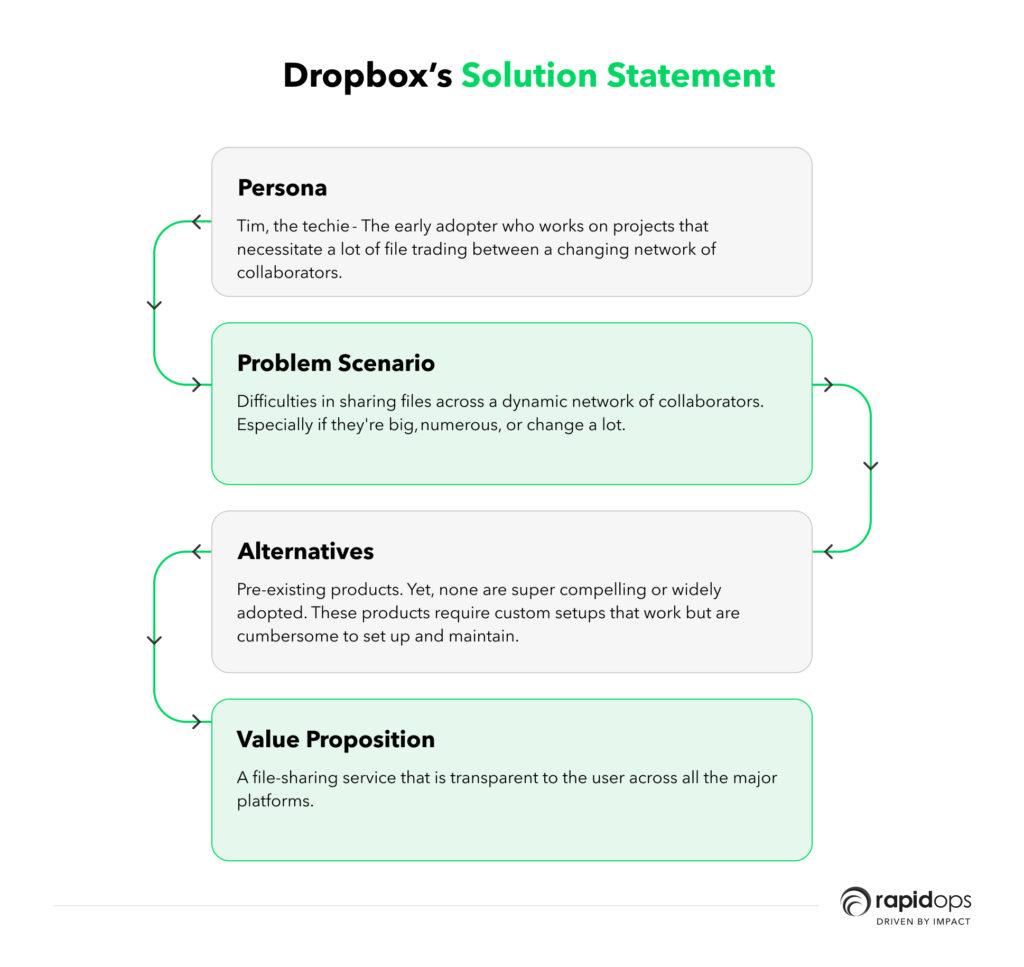
Here's what the Dropbox team did to validate their value proposition:
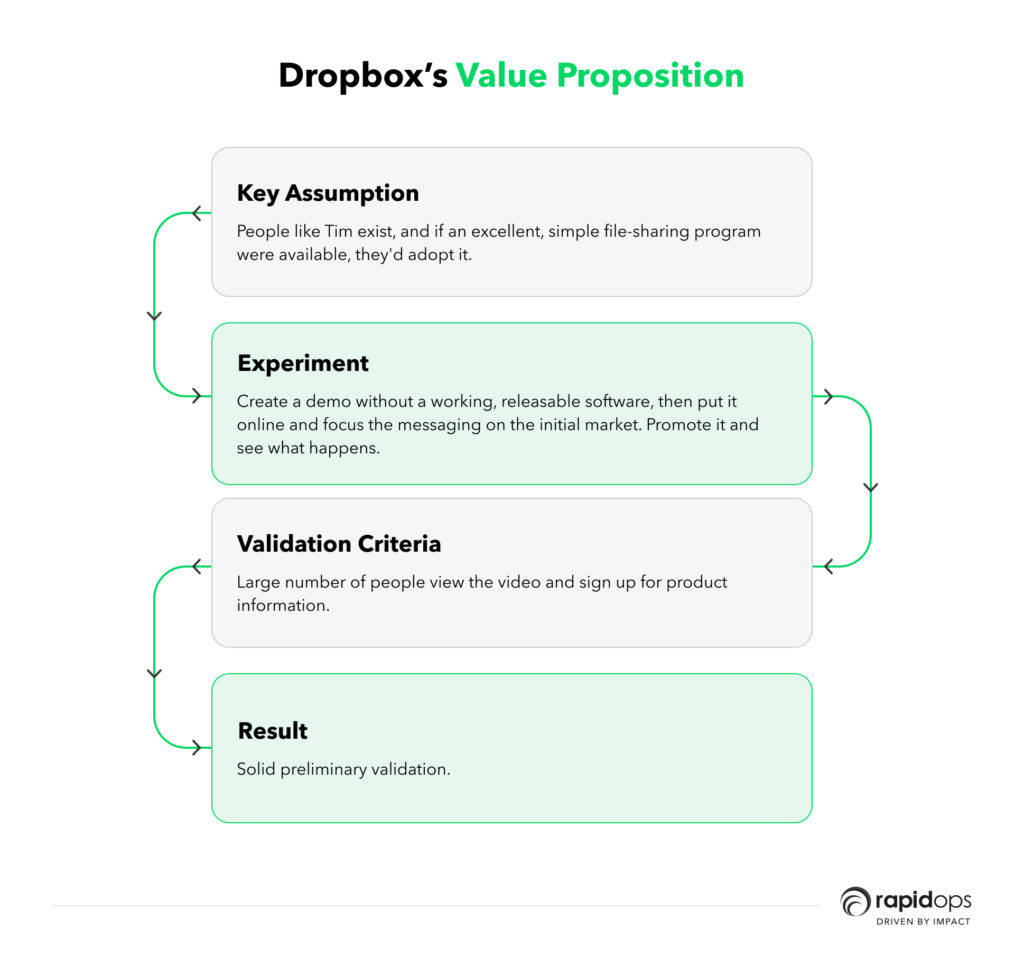
How to create an MVP roadmap?
There are many ways to create an MVP roadmap, but the following steps can be used as a general guide:
MVP roadmap checklist
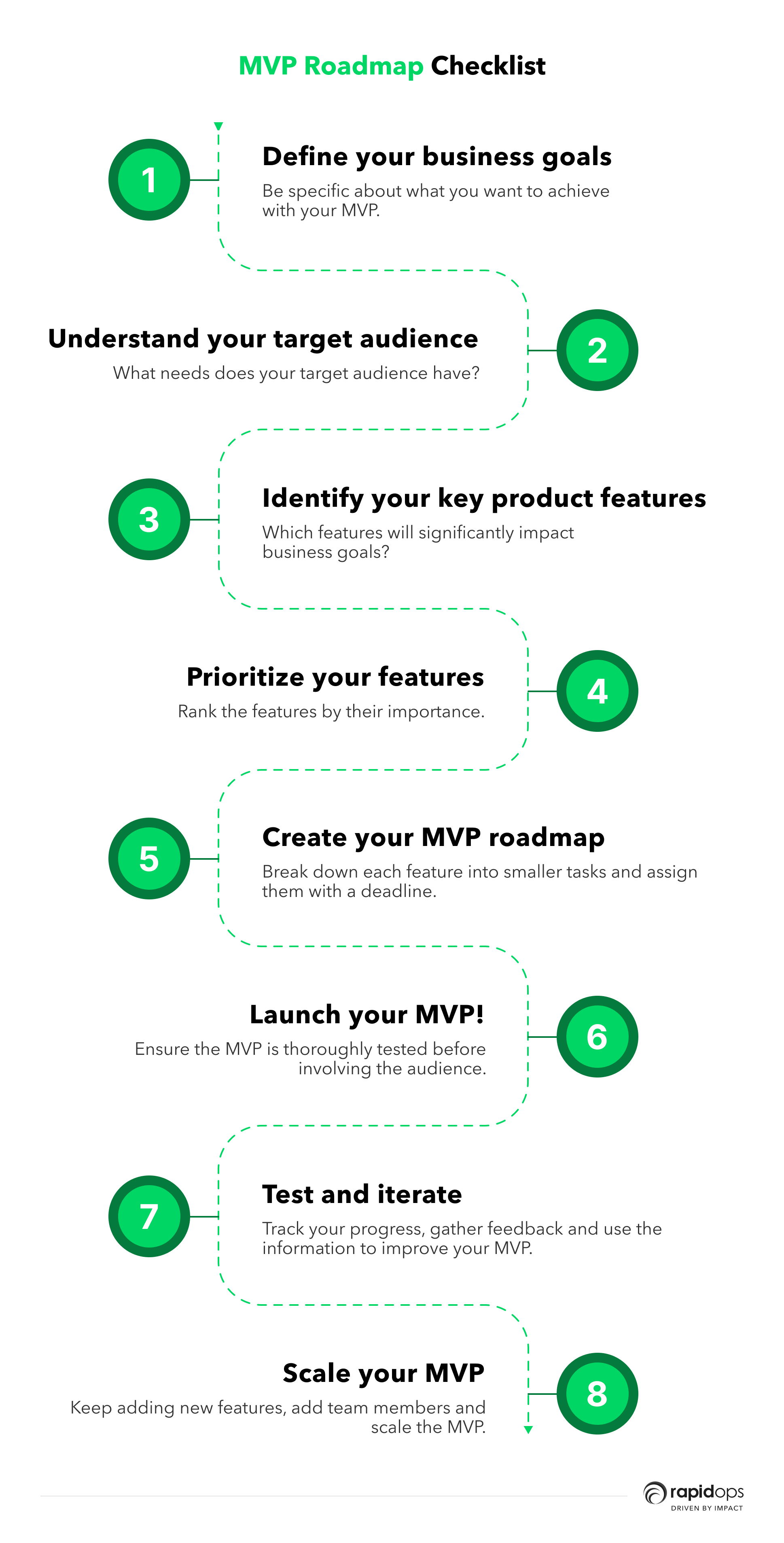
Building an MVP is a great way to validate your business idea and get feedback from your target audience. You can start putting together your MVP roadmap, but before that, here's a quick overview:
1. Define your business goals
What do you want to achieve with your MVP? Be as specific as possible.
2. Understand your target audience
Who are you building your MVP for? What needs does your target audience have?
3. Identify your key product features
What features will have the most significant impact on your business goals?
4. Prioritize your features
Which features should you include in your MVP? Rank them in order of importance.
5. Create your MVP roadmap
Once you've identified and prioritized your features, it's time to build your MVP roadmap. Start by breaking down each feature into smaller tasks that need to be completed. Then, assign each task to a specific team member and set a deadline.
6. Launch your MVP!
The most crucial part of any MVP is the launch. Ensure you've tested your MVP thoroughly before making it available to your target audience.
7. Test and iterate
After launching your MVP, tracking your progress and gathering feedback is essential. Use this feedback to make changes and improve your MVP.
8. Scale your MVP
Once you've validated your MVP, it's time to start scaling it up. This might involve adding new features, expanding your team, or increasing your marketing budget.
Follow these steps, and you'll be on your way to launching a successful MVP in no time!
What is the MVP development process?
MVP is the primary iteration of your market-ready offering in digital product development. MVP is a method of developing a new product by adding core functions and critical, minimum features to see how the intended audience would react.
After several iterations, the product is constructed with all functions based on early adopters' comments.
MVP is a concept that emerged from lean startup and digital product development. MVP helps test, design, and deliver the completed product.
Several businesses run into difficulties when attempting to launch a digital product's minimum viable product. In web development and creation, MVP development is critical.
That is why figuring out the ideal approach to creating a minimum viable product is critical. The goal is to get feedback from your target market or the audience as soon as possible so that you can make the necessary improvements.
Concluding thoughts: Creating MVP is a crucial component of your digital product journey
Remember that an MVP is not about developing a perfect product but rather a good enough product to be used by your target market or audience. It's important not to spend too much time perfecting your MVP before releasing it to the public.
The primary goal is to gather valuable user feedback and iterate quickly, refining the product based on real-world usage and insights.
Characteristics of a well-developed MVP
Before closing out, let's reiterate the crucial characteristics of a well-designed MVP:
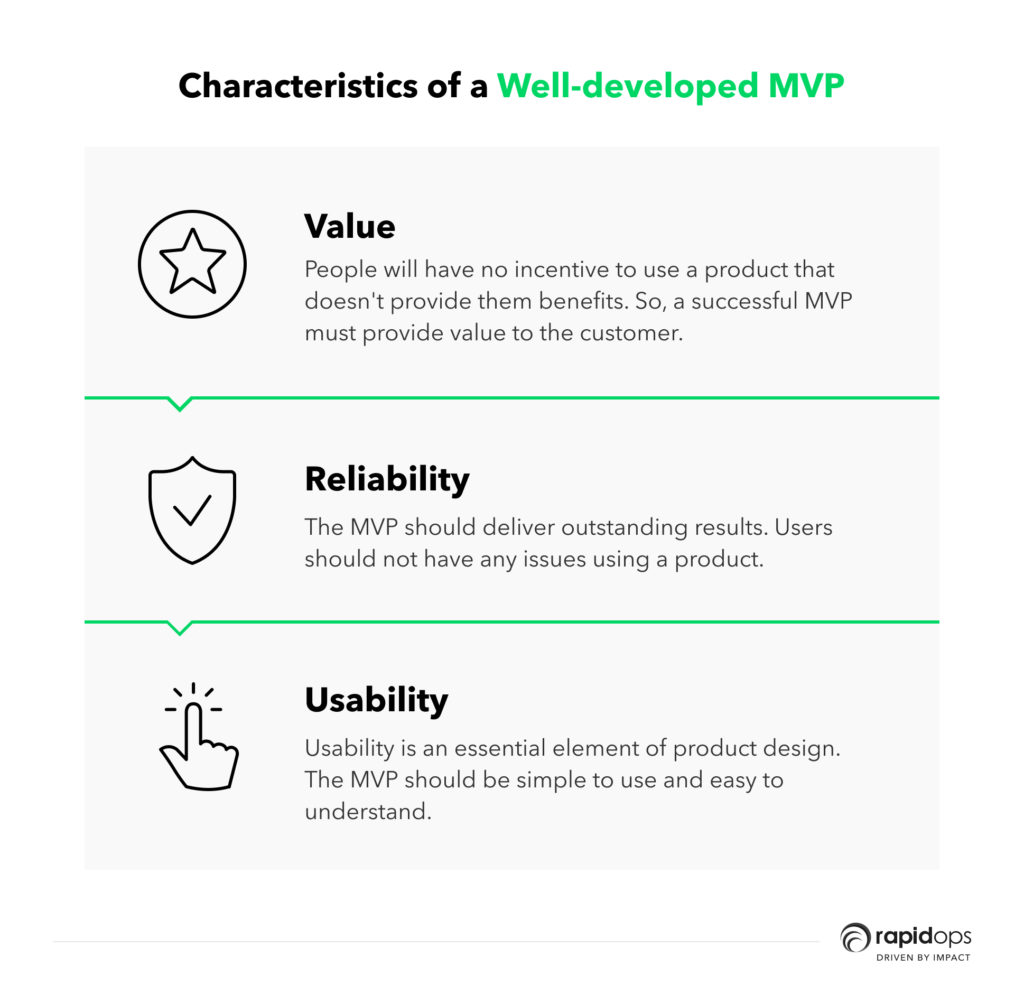
1. Value
That's why the MVP must provide meaningful value to the customer to be successful. Before investing time and effort in developing a product, assess your users' needs. You should spend time and money creating a solution for them only after that.
2. Reliability
The MVP should deliver outstanding results. Users should not encounter any issues while using the product.
3. Usability
Usability is an essential element of product design. The MVP should be simple to use and easy to understand.
View the MVP as a product mock-up that solves users' problems. As a result, it is critical to do user research to comprehend users' requirements and desires and establish correct product features.
Hopefully, this guide has given you a better understanding of MVP roadmaps and how to validate your business idea using them.
When planning your minimum viable product (MVP) roadmap, it's important to consider the bigger picture of your overall digital product strategy. Developing a clear and effective digital product strategy framework can help ensure your MVP roadmap aligns with your business goals and objectives.
At Rapidops, we understand the importance of the right digital product strategy framework. Our experienced team of digital product development experts can work with you to develop a framework tailored to your specific industry, target audience, and business objectives.
With our help, you can ensure that your MVP roadmap is aligned with your overall strategy and designed to meet the needs of your users and customers.
Whether you're just starting out with your digital product development journey or looking to refine your existing strategy, Rapidops is the perfect partner to help you achieve your goals.
Contact us today to learn more about turning ideas into working digital products and how we can help you succeed in today's competitive market. We can smooth out your entire digital product development journey.

Saptarshi Das
Content Editor
9+ years of expertise in content marketing, SEO, and SERP research. Creates informative, engaging content to achieve marketing goals. Empathetic approach and deep understanding of target audience needs. Expert in SEO optimization for maximum visibility. Your ideal content marketing strategist.

Let’s build the next big thing!
Share your ideas and vision with us to explore your digital opportunities
Similar Stories
- Strategy
- undefined Mins
- February 2017

- Strategy
- 19 Mins
- August 2023


Receive articles like this in your mailbox
Sign up to get weekly insights & inspiration in your inbox.

